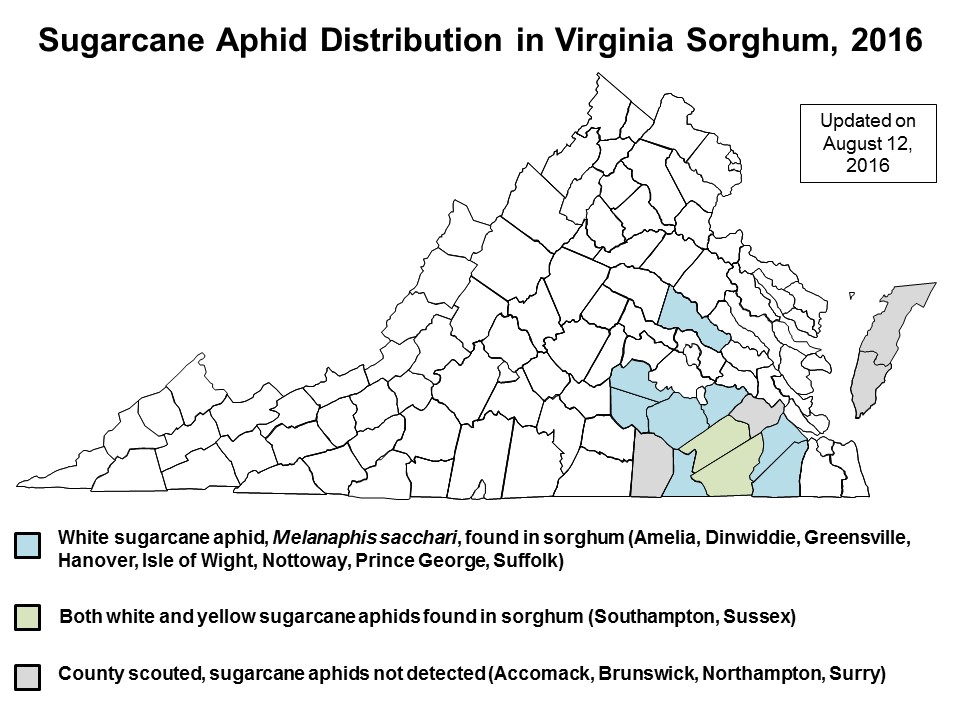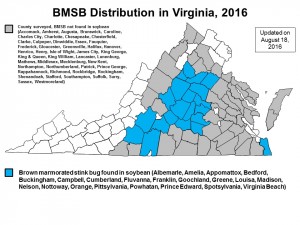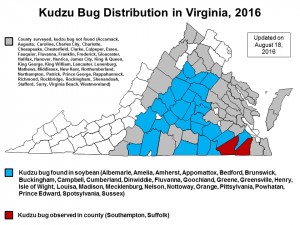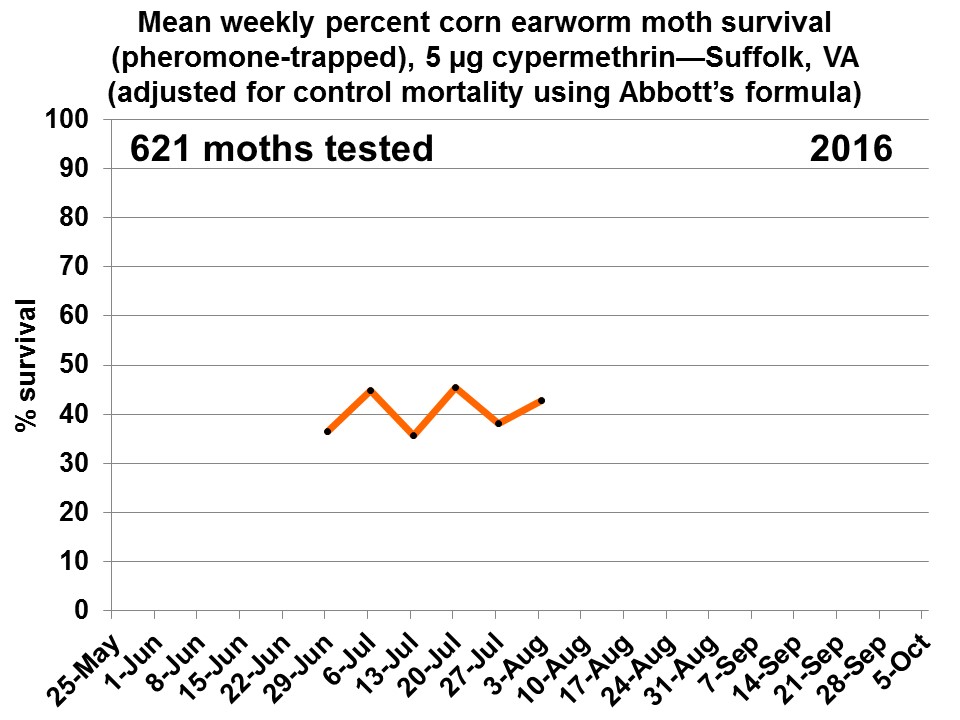Janet Spencer, Isle of Wight County ANR Agent, found white sugarcane aphid in sorghum in her county this week. The current distribution map: :
:
Our scouts Ed and Jamie found brown marmorated stink bug (BMSB) in 5 more Virginia counties this week (Pittsylvania, Spotsylvania, Louisa, Campbell, and Prince Edward). All fields reported were below threshold for BMSB.
Kudzu bugs were found in 4 more counties (Pittsylvania, Mecklenburg, Spotsylvania, and Orange). All fields were below threshold.

At this point in the season, many cotton fields have been treated once for mid-season plant bug/stink bug. The next decision will be focused on bollworm control—whether it is needed, and if so, what insecticides to use. We are seeing a general increase in bollworm moth activity at TAREC and have gotten recent reports of some pretty large worm infestations in a couple of peanut fields in the cotton area, and outbreaks in a couple of soybean fields in the Suffolk area. Caution: if the earlier applied mid-season plant bug/stink bug spray included a pyrethroid (e.g., bifenthrin), the beneficial populations in those fields will have been depleted—which makes them more susceptible to bollworm.
We have plenty of data that shows that cotton varieties with bollworm protection traits can be damaged by worms. Some escape the toxin, survive, and feed on bolls. We have seen as much as 9% or more boll damage in some varieties which is 3 times our working threshold of 3% live worms/fresh boll damage. But, that was in years when bollworm pressure was high. In years like 2014 and 2015 when bollworm populations were very light, we saw essentially no boll damage in any of the varieties. So what is the 2016 situation? So far it looks like we may be looking at heavier pressure than last year, light to moderate depending on the field—but—we won’t know for sure for another few weeks—as the main flight out of field corn has not kicked in yet. The corn crop is generally a little behind and a little less mature than normal for this time of year because of later planting and good rainfall.
The best approach for managing bollworm in cotton is to scout fields for worms by inspecting small bolls, the terminals, and under flowers (boll tags) for live worms or damage. As mentioned, our current threshold is 3% of the fruit or positions inspected with either live worms or damage.
We have a history of bollworm resistance to pyrethroids in Virginia and this year is no exception. Of the 650 or so moths tested so far, we are seeing about 40+% survival. This is high. So for the best control results we suggest using a non-pyrethroid (e.g., Prevathon, Belt, Blackhawk, or Intrepid Edge). Note that Belt is not widely available this season due to the registration being canceled by EPA. Distributors and growers can use existing stocks according to label, but when that is gone, that will be it—at least as far as we know.
We also recommend adding a pyrethroid to the worm product to clean up any plant bugs/stink bugs that may be in the cotton. There are several pyrethroid options, and I would use the highest labelled rate for stink bugs—for better kill and longer residual. Besiege is the only product that contains both the non-pyrethroid (= Prevathon) with a pyrethroid (= Karate). With all the other non-pyrethroids, you will have to do the tank mixing on the farm. And, it is past time to include any of the insecticides in the neonicotinoid class as they do not provide good control of either bollworms or stink bugs.
NIghtly black light trap captures of corn earworm (bollworm) moths rose sharply at most reporting stations this week. Historically, this time of year is when we see our peak moth flight occur, which is followed by egg laying. Mike Arrington (Tidewater AREC Entomology) found an average of 12 bollworm eggs per 100 bloom/bloom tags in Suffolk cotton, which is almost egg threshold (the Pest Management Guide defines the egg threshold as 15-20 eggs per 100 blooms or bloom tags for Bollgard cotton). In peanut, a field near Stony Creek (Sussex Co.) had threshold numbers of corn earworm larvae (4 larvae per row foot when using a beat cloth).
Black light traps caught low to moderate numbers of brown marmorated stink bugs (BMSB) this week, ranging from zero in some locations, to over 5 per night at Warsaw. BMSB findings from the statewide soybean survey are mentioned in my August 9th post. Please see the attached pdf for the black light trap tables for both of these pest species: blt_11_Aug_2016
Our soybean scouts found brown marmorated stink bug (BMSB) in soybean in nine more Virginia counties last week (Goochland, Fluvanna, Albemarle, Buckingham, Greene, Cumberland, Nelson, Bedford, and Franklin). The Bedford soybean field was in the R4 growth stage, and was above threshold with 8 BMSB observed in a 2-minute visual count (the threshold is 3-5). More scouting, management, and other information can be found in the publication, “Brown Marmorated Stink Bug Biology and Management in Mid-Atlantic Soybeans.” Nelson county was just reaching threshold with 3 BMSB in a 2-minute visual count; all other “positive” counties had relatively low numbers of BMSB reported. Here is the map for the season:
Kudzu bugs were detected in nine new Virginia counties last week (Fluvanna, Albemarle, Cumberland, Powhatan, Nottoway, Louisa, Greene, Amherst, and Henry). None of them were near the threshold of 1 kudzu bug nymph per sweep. The kudzu bug map:
 We will continue to provide updates on these insect pests of soybean throughout the season.
We will continue to provide updates on these insect pests of soybean throughout the season.
With the assistance of Johnny Parker and two growers near the town of Franklin, VA, in the past week our Entomology crew was able to capture (via pheromone traps) and test 312 corn earworm (bollworm) moths in our adult vial tests. 41.4% of moths from Franklin survived the 24-hour exposure to the pyrethroid insecticide, cypermethrin. These results are similar to what we are seeing in Suffolk, with a seasonal average of 39.7% of moths surviving the vial test (42.9% surviving in the last week alone). The following line graph shows the Suffolk results in more detail. 
Corn earworm moths are being caught in high numbers in pheromone traps at the Tidewater AREC in Suffolk and at a location near Franklin (Southampton Co.). Janet Spencer also reported an uptick in the moths captured in her pheromone trap in Isle of Wight Co. Black light trap catches of corn earworm moths are on the upswing.
Brown marmorated stink bug catches were 2.9 per night at the Eastern Virginia AREC in Warsaw, and zero at the Tidewater AREC in Suffolk. Please see the attached pdf for detailed trap captures. BLT_4_Aug_2016
We have confirmed white sugarcane aphid (Melanaphis sacchari) in sorghum in three more Virginia counties this week—Suffolk, Prince George, and Dinwiddie. Scott Reiter, Prince George Co. ANR Agent, reported that his aphids came from fields that were below threshold levels and were found along the field edge–very similar to the aphids from Suffolk. Mr. Reiter also had white sugarcane aphids submitted from a Sussex Co. sorghum field. The Dinwiddie aphids were found at Ag Expo. White sugarcane aphid has been found in all the blue and green-colored counties in the map below.
The following information was provided by John Cranmer at Valent U.S.A. Corporation:
“The EPA has approved Zeal for use in soybeans to control spider mites. The unique translaminar movement of Zeal SC reaches mites where they hide and feed, on the underside of the soybean leaves. Formulated as a liquid soluble concentrate, Zeal SC is friendly for the aerial applicator, with easy mixing and a low use rate to treat more acres per load. Soybeans are the latest new crop registration for Zeal SC, following recent expansions into field corn, cotton and melons.”
The states have been notified; watch for approvals for the Zeal soybean label from your state(s) to come in. The supplemental label is attached here: 59639-202_Zeal SC_2016-ZSC-0010.soybean.XNY